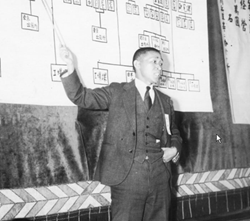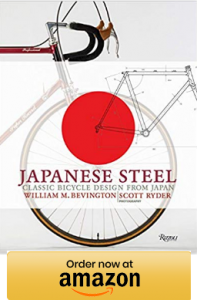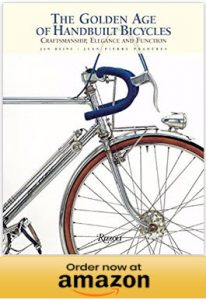 Mr. Konosuke Matsushita was the man behind Panasonic Bicycles. As a child he was adopted into a family who owned a bicycle shop. His passion for bicycles began at an early age. Before long, he was creating new innovations for the benefit of the cycling world.
Mr. Konosuke Matsushita was the man behind Panasonic Bicycles. As a child he was adopted into a family who owned a bicycle shop. His passion for bicycles began at an early age. Before long, he was creating new innovations for the benefit of the cycling world.

In Japan, Mr. Matsushita’s company was known as National. This presented problems when looking to sell products in other countries such as the USA. Consequently, the name Panasonic came about for use on exported products.
Mr. Matsushita was always passionate about his bicycles. Therefore, he refused to put his name on something he considered to be less than a quality product. This would explain why even the inexpensive low-end models such as the Sport 500, had excellent build quality. As a result, they were much nicer than the boat anchor department store bikes being sold at the time.
Matsushita was also known for his Panaracer brand bicycle tires. He created the first successful synthetic tubular tires. Panasonic tubular cement is also highly regarded in the cycling world.
SOME BIKES REMAINED AVAILIBLE
A small number of Panasonic bicycles and frames remain available to North America through Madison, Wisconsin based Yellow Jersey Bicycles. Panasonic began exporting bikes to the U.S. way back in 1971. Those were the early bicycle boom days. For this reason, Panasonic, having been a bicycle maker for many years wanted in on the market.
The National Sales Manager for Panasonic’s bicycles division here in the U.S. was Mr. Norman Halperin. Panasonic was Norman’s initial entry into the bicycle industry – starting with Panasonic on April 19th, 1979 as a Sales Rep covering Metro New York, New Jersey and Connecticut.
GOING NATIONAL AND INCREASED HIRING
At the time Panasonic had only one other Rep in the Chicago area and after another six months he left the company. With only six months experience in the bike business Norman found himself being a senior man in sales department. It was at that point that Panasonic decided to go nationwide and Norman became the National Sales Manager and started hiring reps all over the country.
Panasonic bikes hiding behind other labels…

Certain brands like Schwinn, Raleigh, Royce Union, Suteki, Centurion and other labels all at one time or another had Panasonic built bicycles wearing their badges.
Schwinn’s very first outsourced bikes back in the early 70s were built by Panasonic. These were the “World” bikes such as the World Traveller and World Voyager. Later on in the 70s, Schwinn made a deal with Panasonic bicycles to build the LeTour model which would become the second most popular model for Schwinn in the 1970s.
Panasonic Cycling Teams
Yes, Panasonic supported more than a few cycling teams over the years. We have yet to sort out an official write-up for this web site, so in the meantime have a look here.
Here are some major wins for Panasonic:
- Stage 13 of the 1987 Tour de France (Erik Breukink)
- Stage 1A of the Giro d’Italia 1987 (Erik Breukink)
- Tour of the Basque Country 1988 (Erik Breukink)
- Maillot blanc the 1988 Tour de France 1988 (Erik Breukink)
- Stage 14 of the Giro d’Italia 1988 (Erik Breukink)
- Prologue 1989 Tour de France (Erik Breukink)
- Züri-Metzgete 1984 (Phil Anderson)
- Rund um den Henninger Turm 1984 (Phil Anderson)
- Catalan Week 1984 (Phil Anderson)
- Critérium du Dauphiné Libéré 1985 (Phil Anderson)
- Tour de Suisse 1985, 3 stage wins (Phil Anderson)
- Rund um den Henninger Turm 1985 (Phil Anderson)
- E3 Prijs Vlaanderen 1985 (Phil Anderson)
- Paris–Tours 1986 (Phil Anderson)
- Milano–Torino 1987 (Phil Anderson)
- Dwars door Vlaanderen 1984 (Walter Planckaert)
- Tour of Belgium 1984, 3 stage wins (Eddy Planckaert)
- Omloop Het Volk 1984 (Eddy Planckaert)
- 3 stage wins Paris–Nice (1984 & 1987) (Eddy Planckaert)
- Étoile de Bessèges 1984 (Eddy Planckaert)
- Omloop Het Volk 1985 (Eddy Planckaert)
- 2 stage wins Vuelta a España 1985 (Eddy Planckaert)
- 1 stage wins 1985 Tour de France (Eddy Planckaert)
- E3 Prijs Vlaanderen 1987 (Eddy Planckaert)
- 2 stages Giro d’Italia 1989 (Jean-Paul van Poppel)
- Veenendaal–Veenendaal 1989 (Jean-Paul van Poppel)
CHANGES THROUGH THE YEARS
- 1918 – Mashushita Electric founded. (Parent company that
would eventually be known as Panasonic) - 1923 – A new battery powered bicycle headlamp was developed
and distributed to bicycle dealers.
THE 50’s
- 1951 – Bicycle frame production begins
- 1952 – Production of a roadster-model bicycle by C.K.D.
- National Tire Company established
- 1956 – Sport type bicycle production begins
- 1958 – Received license of sticking certification mark of J.I.S.
(Japan Industrial Standard) for frames from M.I.T.I.
(Ministry of International Trade and Industry)
THE 60’s
- 1962 – Received license of sticking certification mark of J.I.S. for
complete bicycles from M.I.T.I. - 1965 – Factory established in Kashihara city in Osaka, Japan and
National Bicycle Ind. Co. was established - 1967 – Japanese national bicycle racing team adopts use of our
bicycles for World champion competition.
THE 70,s
- 1971 – Began to export Panasonic bicycles to Panasonic
- Company U.S.A. Also began to export bicycles to Schwinn
Bicycle Company U.S.A. - 1972 – Japanese Olympic Bicycle Team adopted our racing
bicycles for Munich Olympics. - 1973 – Reward received for quality control from Osaka division
of M.I.T.I. - 1974 – Gojyo National Bicycle Parts Co. Ltd. established (wheel
assembly factory) - 1976 – Japenese Olympic Bicycle Team adopted our bicycles for
the Montreal Olympics. Only our Racing and 10 Speed - bicycles were selected as up-to-date bicycles among the
- world bicycling manufacturers and demostrated at
Benjamin Franklin Institute in Philadelphia for the
American Bicentenial Celebration. - 1979 – Began to export frames and bicycles to Europe.
- Began to export frames and bicycles to Canada.
- Began to export frames and bicycles to Austrailia.
- Organized Panasonic/Shimano Racing Team in U.S.A.
THE 80’s
- 1980 – Began to export bicycles to T.I. Raleigh (U.S.A.)
- Japanese Olympic Bicycle Team adopted our racing
bicycles for the 1980 Moscow Olympics - 1989 – Panasonic Bicycles pulls out of North American market
